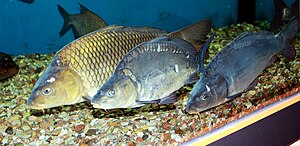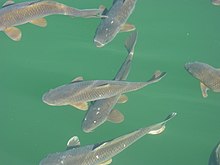| Common carp | |
|---|---|
 | |
| Conservation status | |
 Vulnerable (IUCN 3.1)[1] | |
| Scientific classification | |
| Kingdom: | Animalia |
| Phylum: | Chordata |
| Class: | Actinopterygii |
| Order: | Cypriniformes |
| Family: | Cyprinidae |
| Genus: | Cyprinus |
| Species: | C. carpio |
| Binomial name | |
| Cyprinus
carpio Linnaeus, 1758 | |
Taxonomy

- Cyprinus carpio carpio (European carp) is found in Eastern Europe (notably the Danube and Volga Rivers).[2][4]
- Cyprinus carpio haematopterus (Amur carp) is native to eastern Asia.[4][5]
- Cyprinus carpio rubrofuscus, from Southeast Asia,[4] is treated as a separate species Cyprinus rubrofuscus by many authorities.[6]
History
The common carp is native to Asia which has been introduced to every part of the world with the exception of the Middle East and the poles. The original common carp was found in the inland delta of the Danube River about 2000 years ago, and was torpedo-shaped and golden-yellow in colour. It had two pairs of barbels and a mesh-like scale pattern. Although this fish was initially kept as an exploited captive, it was later maintained in large, specially built ponds by the Romans in south-central Europe (verified by the discovery of common carp remains in excavated settlements in the Danube delta area). As aquaculture became a profitable branch of agriculture, efforts were made to farm the animals, and the culture systems soon included spawning and growing ponds.[9] The common carp's native range also extends to the Black Sea, Caspian Sea and Aral Sea.Both European and Asian subspecies have been domesticated.[4] In Europe, domestication of carp as food fish was spread by monks between the 13th and 16th centuries. The wild forms of carp had reached the delta of the Rhine in the 12th century already, probably also with some human help.[10] Variants that have arisen with domestication include the mirror carp, with large, mirror-like scales (linear mirror – scaleless except for a row of large scales that run along the lateral line; originating in Germany), the leather carp (virtually unscaled except near dorsal fin), and the fully scaled carp. Koi carp (錦鯉 (nishikigoi) in Japanese, 鯉魚 (pinyin: lĭ yú) in Chinese) is a domesticated ornamental variety that originated in the Niigata region of Japan in the 1820s.[11] They also invaded the Great Lakes in 1896 when the area near Newmarket, Ontario, flooded and allowed them to escape into the Holland River.
Physiology

Habitat

Diet
Common carp are omnivorous. They can eat a vegetarian diet of water plants, but prefer to scavenge the bottom for insects, crustaceans (including zooplankton), crawfish, and benthic worms.Reproduction
An egg-layer, a typical adult female can lay 300,000 eggs in a single spawn.[18] Although carp typically spawn in the spring, in response to rising water temperatures and rainfall, carp can spawn multiple times in a season. In commercial operations, spawning is often stimulated using a process called hypophysation, where lyophilized pituitary extract is injected into the fish. The pituitary extract contains gonadotropic hormones which stimulate gonad maturation and sex steroid production, ultimately promoting reproduction.Predation
A single carp can lay over a million eggs in a year,[3] yet their population remains the same, so the eggs and young perish in similarly vast numbers. Eggs and fry often fall victim to bacteria, fungi, and the vast array of tiny predators in the pond environment. Carp which survive to juvenile are preyed upon by other fish such as the northern pike and largemouth bass, and a number of birds (including cormorants, herons, goosanders, and ospreys)[19] and mammals (including otter and mink).Introduction into other habitats




Efforts to eradicate a small colony from Tasmania's Lake Crescent without using chemicals have been successful, but the long-term, expensive and intensive undertaking is an example of both the possibility and difficulty of safely removing the species once it is established.[21] One proposal, regarded as environmentally questionable, is to control common carp by deliberate exposing them to carp-specific Koi herpes virus with its high mortality rate. In Utah Lake, the common carp's population is expected to be reduced by 75% by using nets to catch millions of them and either give them to people who will eat them or processing them into fertilizer. This, in turn, will give the native June sucker a chance to recover its declining population. Another method is by trapping them in tributaries they use to spawn with seine nets and exposing them to rotenone. This method has shown to reduce their impact within 24 hours and greatly increase the native vegetation and desirable fish species. This also leaves the baby carp easily preyed upon by native fish.
In Australia, enormous anecdotal and mounting scientific evidence indicates introduced carp are the cause of permanent turbidity and loss of submergent vegetation in the Murray-Darling river system, with severe consequences for river ecosystems, water quality and native fish species.[22] In Victoria, Australia, common carp has been declared as noxious fish species, the quantity a fisher can take is unlimited.[23] In South Australia, it is an offence for this species to be released back to the wild.[24] An Australian company converts common carp into plant fertilizer.[25]
Common carp were brought to the United States in 1831.[26] In the late 19th century, they were distributed widely throughout the country by the government as a food-fish, but they are no longer prized as a food-fish. As in Australia, their introduction has been shown to have negative environmental consequences,[27] and they are usually considered to be invasive species. Millions of dollars are spent annually by natural resource agencies to control common carp populations in the United States.[22]
Common carp are believed to have been introduced into the Canadian province of British Columbia from Washington. They were first noted in the Okanagan Valley in 1912, as was their rapid growth in population. Carp are currently distributed in the lower Columbia (Arrow Lakes), lower Kootenay, Kettle (Christina Lake), and throughout the Okanagan system.[28]
As food and sport
See also: Carp
fishing
Cyprinus carpio is the number one fish of aquaculture. The annual
tonnage of common carp, not to mention the other cyprinids, produced in China alone exceeds
the weight of all other fish, such as trout and salmon, produced by aquaculture
worldwide. Roughly three million tonnes are produced annually, accounting for
14% of all farmed freshwater fish in 2002. China is by far the largest
commercial producer, accounting for about 70% of carp production.[17]
Carp is eaten in many parts of the world both when caught from the wild and
raised in aquaculture. In Central Europe, it is a
traditional part of a Christmas Eve dinner. Many
people in Poland
and Czech Republic buy a live
carp and bring it home three or two days before Christmas Eve. It is kept one or
two days in a bathtub, and then killed.
Traditional Czech Christmas Eve dinner is thick soup of carp's head and offal,
fried carp
meat with potato salad or boiled carp
in black sauce. In some Czech families, the carp is not killed, but after
Christmas returned to a river or pond. In Western Europe, the carp
is cultured more commonly as a sport fish, although there is a small market as
food fish.[29][30]
Carp are mixed with other common fish to make gefilte fish, popular in Jewish
cuisine.Common carp are extremely popular with anglers in many parts of Europe, and their popularity as quarry is slowly increasing among anglers in the United States (though destroyed as pests in many areas), and southern Canada. Carp are also popular with spear, bow, and fly fishermen.
The Romans farmed carp and this pond culture continued through the monasteries of Europe and to this day. In China, Korea and Japan, carp farming took place as early as the Yayoi Period (c. 300 BC – 300 AD).[31]
Carp eggs used for caviar is an increasing popularity in the United States.[c
- Article Source: http://en.wikipedia.org/
More Stories: http://gofishtalk.com/
No comments:
Post a Comment